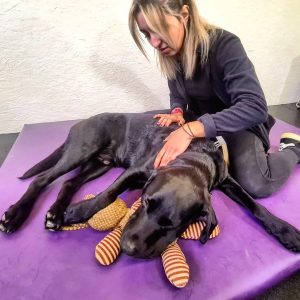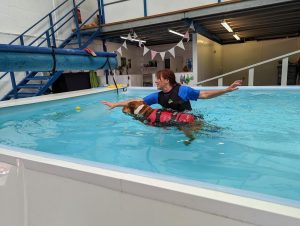Osteoarthritis (OA), commonly known as arthritis, is the inflammation of a joint that leads to pain and reduced mobility. Over time, the smooth cartilage that covers the surface of joints wears down, causing the exposed bones to rub together, which worsens the condition.
Several factors can predispose a dog to developing OA, including:
- Genetics, breed, and body structure – such as developmental disorders like hip or elbow dysplasia
- Age-related wear and tear
- Obesity – excessive weight puts extra strain on joints
- Previous injuries – including joint trauma or surgeries
What Are the Main Symptoms of Osteoarthritis?
Symptoms of OA can vary depending on the severity of the disease. However, the most common signs include:
- Stiffness, difficulty getting up or lying down
- Slower movement or reluctance to exercise
- Limping or lameness
- Muscle wasting/atrophy
- Changes in personality – increased irritability, anxiety, or withdrawal
- Licking of affected joints
Early detection is critical for maintaining your dog’s quality of life. Studies show that 40% of dogs under the age of four have radiographic evidence of OA, although only half of these cases can be identified through a physical exam. This means many cases go unnoticed, making it essential for both pet owners and vets to stay vigilant.
Prevention is key. If your dog belongs to a predisposed breed or is overweight, it’s time to consult one of our vets to explore preventive measures.
How Is Osteoarthritis Diagnosed?
If you notice any of the symptoms listed above in your dog, it’s important to consult a vet. At The Canine Fitness Centre, we offer full assessments to evaluate your dog’s mobility and identify subtle signs of discomfort.
X-rays may be recommended to assess the severity of the joint disease, and blood tests can help rule out other medical conditions that could impact treatment. Additionally, we may suggest a “pain trial” with a Vet using a specific medication to observe its effect on your dog’s mobility and comfort.
How Can We Treat Joint Pain?
Unfortunately, there is no cure for OA, but treatment focuses on relieving symptoms, improving mobility, and slowing disease progression. Treatment options may include:
- Exercise management – regular short walks on flat terrain
- Weight loss – weight control and special joint diets can be helpful
- Physiotherapy and hydrotherapy – maintaining muscle mass and enhancing joint flexibility
- Laser therapy
- Myotherapy
- Acupuncture
- Nutraceuticals – joint supplements may help slow the disease’s progression
- Environmental modifications – using orthopaedic bedding, ramps, non-slip mats, or carpeting
- Medication – Various medications are available to manage pain and inflammation. Some dogs respond well to a single medication, while others may need a combination of treatments. Options include:
- Anti-inflammatory drugs (NSAIDs)
- Monoclonal antibody injections
- Pain relievers
- Joint injections
In some cases, surgery may be considered to stabilise the joint, such as arthroplasty or total hip replacements for severe OA.
During a Canine Fitness consultation, our veterinary Physiotherapists can help you navigate the available treatment options and create a long-term pain management plan tailored to your dog’s needs.
Don’t wait—book an appointment today for a mobility assessment, and let’s discuss how to ensure your dog’s comfort for the future.













